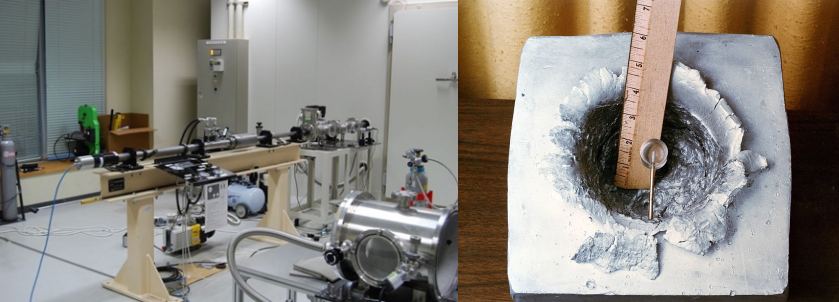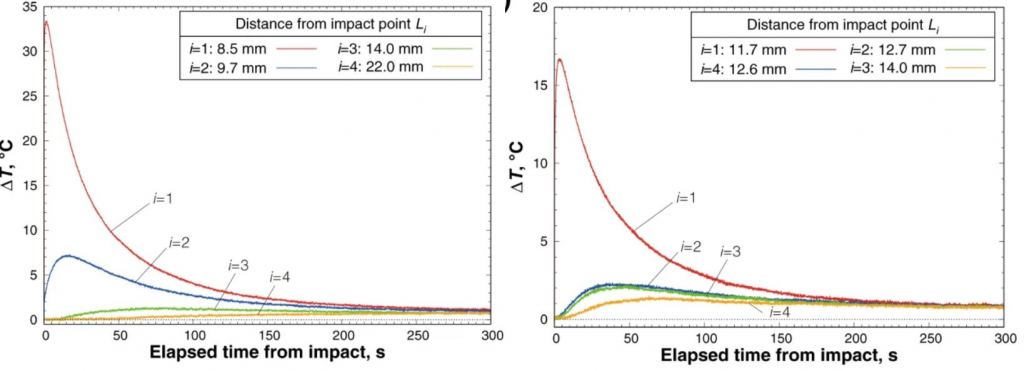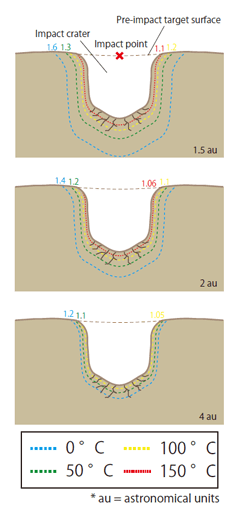This is our Great Question: How did life begin on Earth? Anyone who says they have the answer is telling tall tales. We just don’t know yet.
While a definitive answer may be a long way off—or may never be found—there are some clever ways to nibble at the edges of that Great Question. A group of researchers at Kobe University in Japan are taking their own bites out of that compelling question with a question of their own: Did the heat from asteroid impacts help life get started?
This team of researchers is not the first to wonder about asteroid impacts and what role they may have played in the appearance of life on Earth. But rather than focus on asteroids impacting Earth and delivering water and chemicals, they’re looking at impacts between asteroids and other small bodies. It’s possible that the heat from those impacts generated water and life-origin chemicals on the asteroid’s surface, then delivered to Earth.
The group of scientists started with an asteroid proxy made of porous gypsum as a target. They placed thermocouples inside their asteroid to measure heat. Then they created high-velocity impacts by accelerating projectiles with Kobe University’s gas gun. Their two-stage gas gun is specialized physics equipment that can accelerate things to extremely high velocities.

A critical idea behind their experiment is aqueous alteration and the heat required to create it. Aqueous alteration is when minerals in rock change because of chemical reactions with water. Those reactions can create organic solids. But for those reactions to take place, there must be heat to melt the asteroid’s ice. In larger bodies, scientists think that the decay of Aluminum 26, a radioactive isotope, can provide heat for aqueous alteration. But that only occurs in larger asteroids of about 10km in diameter and may only have occurred in the Solar System’s first 10 million years or so before all of the Al 26 had decayed. Could aqueous alteration have occurred due to impacts on smaller asteroids much later into the Solar System’s life?
They monitored the temperature created by the impacts as they raised the velocity of their projectiles. They wanted to know not only how much heat was generated but how long that heat would persist. Could asteroid impacts create enough heat to create life-origin chemicals without destroying the asteroids themselves? How widespread are these conditions in the Solar System, and could these chemicals still be generated in older Solar Systems like ours?
In their paper, the team pointed out that in the main asteroid belt the relative velocity among asteroids is about 4 to 5 km/second. The shock of those collisions would’ve immediately raised the temperature around the resulting crater. Collisions like these were common in our Solar System’s youth, long after all of the Al 26 had decayed. The heat from these impacts would’ve been most pronounced on more porous asteroid bodies. There’ve been many numerical studies of the heat from these impacts, but the authors of this paper say theirs may be the first time they’ve been studied directly.
The researchers used different types of projectiles travelling at different velocities to develop a model of impact heating. The image below shows some of their experimental results.

With their experimental data in hand, the team developed a rule of thumb for the effects of impact heating on asteroids. The heat conduction model based on that rule allowed them to calculate the heat distribution around the impact crater. Then they compared their model against what is known about aqueous alteration and the formation of organic solids from analyses of meteorites.

Overall, the researchers found that the potential for asteroid impacts to create chemicals necessary for life is more widespread than thought. It’s more widespread both spatially and temporally, and the necessary heat can be created from impacts that create craters as small as 100 m in diameter. The team says that their results increase the number of astronomical bodies that could have delivered water and organic substances for the origin of life on Earth.
Another interesting result of their work involves organic solids that originated in the nebular cloud at the very beginning of our Solar System’s formation. The team showed that the heat from impacts may be like a double-edged sword. Not only can that heat forge new organic materials, but it can destroy the same type of materials present on asteroids and asteroid parent bodies since the early days.
We may never know exactly what led to the appearance of life on Earth. But we can at least build a trail of evidence that leads to the necessities for it to appear. If this paper is correct in its conclusion, then the creation of some of the chemicals necessary for life might be more common than thought.
But that doesn’t mean life is.
The paper presenting these results is titled “Impacts may provide heat for aqueous alteration and organic solid formation on asteroid parent bodies.” It’s published in the journal Nature Communications Earth and Environment. The first author is Minami Yasui, lecturer at Kobe University’s Graduate School of Science.
More:
- Research Paper: Impacts may provide heat for aqueous alteration and organic solid formation on asteroid parent bodies.
- Press Release: Did heat from impacts on asteroids provide the ingredients for life on Earth?
- Universe Today: Rosetta Saw the Building Blocks of Life on Comet 67P


I’m sure the biochemists that make up the minority of astrobiologists would like to claim that there isn’t common methods of science that has predicted how life evolved on Earth. That does not make it fact, and the majority of biologists, geologists and astrophysicists are fairly comfortable with their findings.
Such as a phylogenetic tree shows biology split from geology in alkaline hydrothermal vents of the then likely global ocean [ https://www.nature.com/articles/nmicrobiol2016116 ]. Of course someone can come up with a better tree (and methods!) but the tree has withstood years of scrutiny.